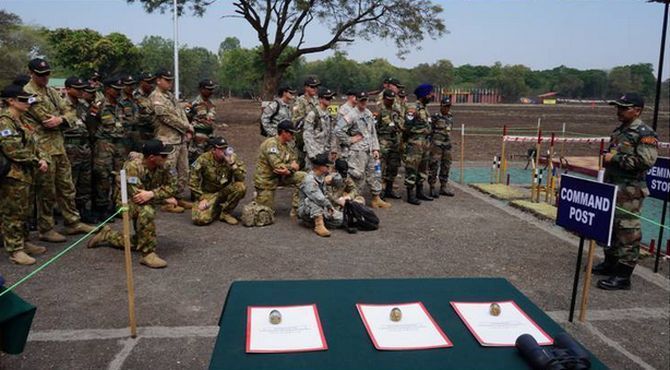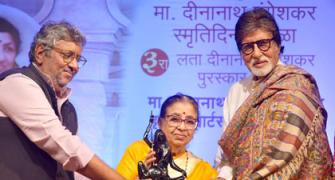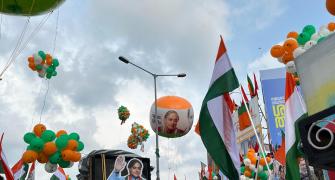India is no longer shying away from playing a role on the regional and international stages and is willing to don a bigger role in regional politics. It is showing traits of a responsible stakeholder in the regional security dynamics, says Dr Rahul Mishra.

Concluding today is one of the biggest-ever multi-nation field training exercises hosted by India. The six-day long Exercise Force 18, conducted under the framework of the ASEAN defence ministers’ meetings plus, is being undertaken since March 2 at the Aundh military station at the headquarters of the southern command of the Indian Army at Pune. The Association of Southeast Asian Nations and eight other member countries of the ADMM Plus are participants in Exercise Force 18, which is themed around ‘Humanitarian mine action’ and ‘peacekeeping operations’.
The ‘18’ in Exercise Force 18 denotes the number of participating countries: The 10 ASEAN member States (Brunei, Cambodia, Indonesia, Lao PDR, Malaysia, Myanmar, the Philippines, Singapore, Thailand, and Vietnam), Australia, China, India, Japan, New Zealand, Russia, Republic of Korea, and the US, with the participation of over 360 military personnel from these countries. The exercise has been defined as an upshot of the sustained efforts by New Delhi in bringing more synergy with ASEAN members and the other seven of the “Plus Eight” ADMM Plus partner countries.
The forum for ASEAN defence ministers’ meeting -- the ADMM Plus -- had originally planned for two separate exercises for humanitarian mine action and UN peace-keeping operations in 2016. According to official statements during the ADSOM (ASEAN defence senior officers’ meeting) Plus held in Malaysia in March 2015, India had offered to host these two exercises together and jointly conduct the FTX in 2016.
While the stated objective of Exercise Force 18 is to ‘build common understanding and achieve inter-operability among the 18 ASEAN Plus countries’, the joint exercise is also driven by three other objectives.
First, the exercise is aimed at improving coordination among the armed forces personnel and collective response time of the regional stakeholders in the face of transnational natural disasters and other non-traditional security challenges.
Second, it is expected that the exercise will facilitate understanding among the armed forces of the ADMM Plus countries, and help them socialise with one another. This is particularly important in view of the fact that few participant countries are still involved in territorial disputes in the region. For instance, a military standoff between the Filipino and Chinese soldiers due to differing perceptions of their shared border is a common problem faced by both the countries.
Finally, the exercise is also to gain knowledge of the best practices in HADR (humanitarian assistance and disaster relief) operations among the participating armed forces. In essence, the exercise is a concerted joint effort towards a lasting peace and stability of the region.
The exercise has added substance to India’s Act East Policy. India’s soft as well as hard power capabilities are projected well in the exercise as India possesses one of the strongest militaries in the world.
Another important development was that despite its ongoing maritime dispute in the South China Sea and the East China Sea, China has agreed to be a part of the drill, as did the US and Russia, despite several differences. It is clear that China did not want to be left out of such a region-wide military exercise.
From a strategic perspective, the timing of the exercise is crucial. India’s relations with the ASEAN member States have already been given yet another boost with the recently concluded Delhi Dialogue-India’s annual track 1.5-level dialogue to discuss issues of mutual interests in the economic, political, cultural and strategic domains between India and the ASEAN, on February 17-18, 2016. As a part of its Act East policy, India has been actively engaging the ASEAN member States, China, and countries of Northeast Asia -- Japan and South Korea, through economic, institutional and strategic arrangements.
The Look East policy, rechristened as Act East policy by the Prime Minister Narendra Modi-led government, has successfully entered its new phase. The first phase (1991-2000) revolved around the sole purpose of enforcing institutional linkages and strengthening economic ties between India and the ASEAN. India-ASEAN trade has increased manifold since 1991 and now India is ASEAN’s ninth largest trading partner, whereas ASEAN is India’s fourth largest trading partner. The two-way annual trade has already reached the US$ 80 billion mark.
The Second phase (2001-2010) of the Look East policy focused on politico-strategic, institutional, and regional integration arrangements. India became a member of the East Asia Summit and the ADMM Plus and the first meeting of the ADMM Plus was convened in 2010 in Hanoi, Vietnam. It was then that India got an opportunity to further strengthen cooperation with the region in the domains of “maritime security, counter-terrorism, humanitarian assistance and disaster management, peacekeeping operations and military medicine -- the five areas of cooperation identified in the first ADMM Plus meeting.
With its Act East Policy, India is no longer hesitant to show its benign military strength in the region, and is confidently working with the armed forces of countries across the Asia Pacific region. India has been hosting the Malabar and MILAN multi-nation exercises for more than two decades now. These exercises involve the Southeast Asian countries. The point of difference, however, is that, such exercises do not involve ASEAN as a “unit” but just its member countries in their individual capacities.
These recent developments have made it clear that India is no longer shying away from playing a role on the regional and international stages and is willing to don a bigger role in regional politics. India is showing traits of a responsible stakeholder in the regional security dynamics. Importantly, it will strengthen India’s relationship with ASEAN in general and individual ASEAN and ADMM Plus countries in particular.
Countries such as the US, Japan, Vietnam and the Philippines welcome India’s increased presence in the region as they perceive India as an effective counterweight against China’s assertive postures in the South China Sea. However, it is still unlikely that China will be confronted with India’s naval presence in the disputed South China Sea.
A successful hosting of Exercise Force 18 would facilitate India in establishing itself as a credible major power in the Asia-Pacific region. It will further contribute to the increasing trust between India and the countries of the region including Japan, South Korea, China, and the ASEAN member countries among others.
Image: Multinational forces witnessing a lecture and demonstration during Exercise Force 18. Photograph: Indian Army on Twitter.
Dr Rahul Mishra is a Research Fellow at the Indian Council of World Affairs, New Delhi. The views expressed do not represent the views of the ICWA.










